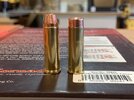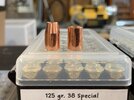I thought soot at the mouth of a fired case was caused by low charge weights not sealing the case in the chamber and was unavoidable when shooting softer target loads. Then I loaded 148 gr. plated wadcutters at pretty low charge rates of 4.0, 4.2, 4.4 and 4.6 grains of HP-38. Those cases were surprisingly clean compared to the ones I fired with 5.4 grains of HP-38 and a 125 gr. plated FN bullet.
In this video, the first case was a 125 gr. Berry's plated bullet powered by 5.4 grains of HP-38. The next four were 148 gr. Berry's plated wadcutter powered by 4.0, 4.2, 4.4, and 4.6 gr. None of those cases exhibit the sooty mouth like the higher powered 125 gr. bullet. How is it the case with the higher charge has more soot on it than those with lower charges?
In this video, the first case was a 125 gr. Berry's plated bullet powered by 5.4 grains of HP-38. The next four were 148 gr. Berry's plated wadcutter powered by 4.0, 4.2, 4.4, and 4.6 gr. None of those cases exhibit the sooty mouth like the higher powered 125 gr. bullet. How is it the case with the higher charge has more soot on it than those with lower charges?



